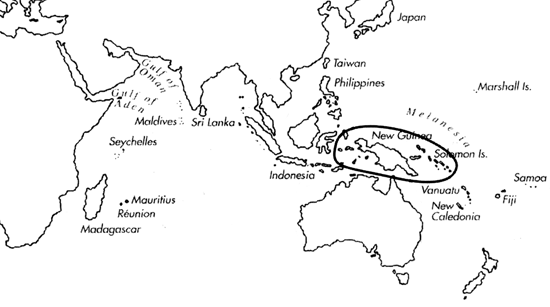
Skip Navigation Links
View access keys for this site.

Range: Indonesia, Papua New Guinea, and Solomon Is.
Description: Moderately small, moderately light to moderately solid. Last whorl ventricosely conical, occasionally slightly pyriform in form nahoniaraensis; outline variably convex adapically, less so to slightly concave basally. Shoulder subangulate to rounded. Spire of low to moderate height, outline concave or sigmoid. In form nahoniaraensis, larval shell of about 2 whorls, maximum diameter about 0.7 mm; typical form with a maximum diameter of about 0.8 mm. Teleoconch sutural ramps flat to slightly convex; later ramps with 3-5 incrcasing to 5-8 fine spiral grooves; in last 1-2 whorls, spiral sculpture may be weak or have additional spiral striae. Last whorl with widely spaced axially striate spiral grooves on basal third to half, ribbons between narrower or grading to ribs near base.
| Shell Morphometry | ||
|---|---|---|
| L | 25-33 mm | |
| RW | 0.07-0.12 g/mm | |
| RD | 0.54-0.65 | |
| (-form nahoniaraensis 0.58-0.61) | ||
| PMD | 0.75-0.84 | |
| RSH | 0.10-0.17 | |
Ground colour white to cream or grey; bluish or purplish grey in form nahoniaraensis (Pl. 40, Figs. 31-33). Last whorl with orangish to blackish brown axial flames from base to shoulder ramp, partially as axial rows of spots toward base. Shells with variably interrupted axial markings intergrade with shells primarily with spiral rows of dots, dashes and bars that tend to fuse into axial streaks and blotches. Form nahoniaraensis with axially as well as spirally arrayed separate brown spots that fuse axially. Apex brown; later postnuclear sutural ramps with orangish to blackish brown radial markings. In form nahoniaraensis, larval whorls white to light brown, early postnuclear sutural ramps grey to brown, and late sutural ramps with very sparse radial maculation. Aperture blue or violet, with brown collabral band; colour more prominent in form nahoniaraensis.
Periostracum grey, thin, translucent, smooth.
In E. New Britain, animal reported to be brown with white flecks, and with brown transverse stripes on the siphon (Richards, pers. comm., 1989).
Habitat and Habits: Intertidal to about 30 m. In E. New Britain, in 1-2 m as well as in about 30 m (Richards, pers. comm., 1989). Form nahoniaraensis on sand bottom in 2- 18 m (Bailey, pers. comm., 1986).
Discussion: C. zebra is very similar to C. stramineus and C. subulatus. C. stramineus attains larger size (L 33-52 mm), has a more angulate shoulder in similarly sized shells, and the spiral sculpture on its late sutural ramps is distinctly coarser. Its last whorl pattern has a primarily spiral arrangement and forms spiral bands, while that of C. zebra is predominantly axially rather than spirally arranged and has axial flames. C. subulatus differs in having a narrower last whorl (RD 0.51-0.54) and a violet aperture without a brown collabral band. The holotype of C. zebra is in poor condition, and the type locality is unknown. However, specimens from the Solomon Is. (Pl. 40, Fig. 27) as well as from Indonesia (Pl. 40, Fig. 30) correspond closely enough with the type (Pl. 40, Fig. 26) to justify their identification as C. zebra. Specimens from E. New Britain (Pl. 40, Figs. 28, 29) with an often narrower last whorl (RD 0.54-0.60) and an axially as well as spirally arranged pattern are almost identical in size, weight, sculpture and colouration and intergrade with the typical form in shape and pattern. We therefore consider them conspecific with C. Zebra. Specimens described as C. nahoniaraensis also occur in the Solomon Is., with typical C. zebra. They may have a slightly pyriform shape and differ slightly in colour pattern of the last whorl as well as the spire, although some specimens have a zebrine pattern on the last whorl and sutural ramps. As they are not separable from C. zebra by shell morphology, we provisionally assign them to this species as a form.

C. zebra range map
This section contains verbatim reproductions of the accounts of 316 species of Conus from the Indo-Pacific region, from Manual of the Living Conidae, by Röckel, Korn and Kohn (1995). They are reproduced with the kind permission of the present publisher, Conchbooks.
All plates and figures referred to in the text are also in Röckel, Korn & Kohn, 1995. Manual of the Living Conidae Vol. 1: Indo-Pacific Region.
The range maps have been modified so that each species account has it own map, rather than one map that showed the ranges of several species in the original work. This was necessary because each species account is on a separate page on the website and not confined to the order of accounts in the book.
Return to framed version (returns to search page)